 Hazardous Waste Management
Hazardous Waste ManagementA waste with properties that make it dangerous or capable of having a harmful effect on human health or the environment.

2021 | AIT RRC.AP
Keywords: mecury, medical measuring devices
Mercury and mercury compounds are highly toxic substances with adverse effects on humans1, ecosystems2, and wildlife3. Initially seen as an acute, localized hazard, mercury pollution is now recognized as a global problem, threatening populations and ecosystems distant from the point source of emissions at risk from its toxic effects. As of 2019, it is ranked third in the substance priority list of the US Agency for Toxic Substances and Diseases Registry (ATSDR), just below arsenic and lead, and has been in the list of substances for “virtual elimination” since 1997.

2021 | AIT RRC.AP
Keywords: mercury, medical measuring devices
This guidelines comprehensively contain national policies and regulations, an overview of mercury-containing medicle measuring devices and their alternatives, environmentally sound management of unbroken mecury-containing medicle measuring devices, enviornmentally sound management of broken mercury containing medicle measuring devices health and safety, emergency response, and guidance and supervision
2009 | Department of Hospital Services, Ministry of Health, Cambodia
Keywords:
The majority of activities associated with healthcare result in the production of waste that may lead to disability and death. Although a large fraction of healthcare waste is very similar to domestic solid waste, there are some healthcare wastes which must be handled and managed properly to reduce or eliminate the risk to health. Medical waste is one of the most problematic componenets of solid waste mangement. Medical waste mangement in Phnom Penh City is very poor and as a consequence potentially harmful to public health and environment. It is actually difficult to give precise numbers of people affected by improper management of medical waste.
| Goverment of Inda, Department of Adomic Energy
Keywords:
TOMIC ENERGY (SAFE DISPOSAL OFRADIOACTIVE WASTES) RULES, 1987.(February 3, 1987)G.S.R. 125.” In exercise of the powers conferred by sub-section (1) read with clause (i) of sub-section (2) of Section 30 and clause (b) of sub-section (1) of Section 17 of the Atomic Energy Act, 1962 (33 of 1962) and all other powers enabling it in this behalf, the Central Government hereby makes the following rules.
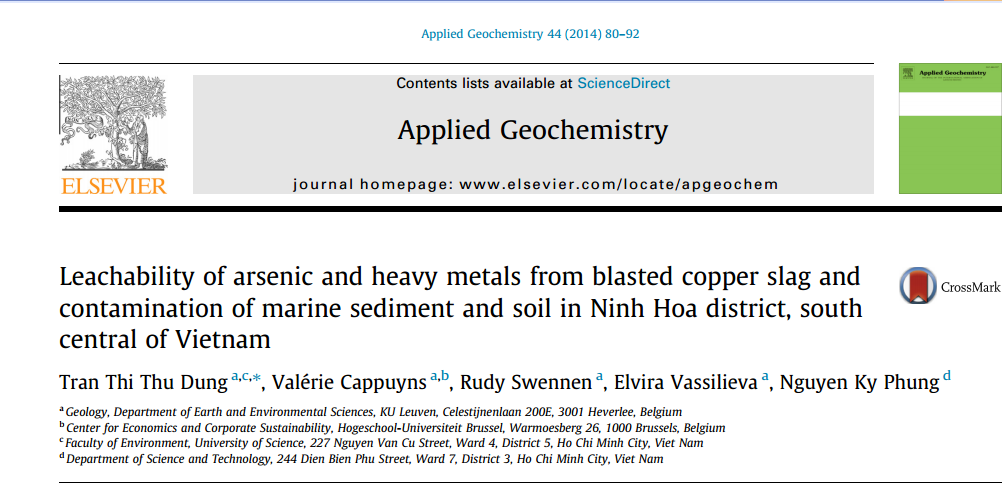
2014 | Elsevier
Keywords: Heavy metal, marine sediment, soil contaminant
In recent years, shipping activities developed in Ninh Hoa district (south-central Vietnam), have raised an urgent environmental concern related to the use of copper slag as abrasive material for removing rust from the surface of the ships. This study was conducted to investigate the characteristics of the blasted copper slag (BCS). Enrichment Factors (EF) were used to assess the contamination status of sediments and soils in the surroundings of the BCS dump site. The potential release of As and heavy metals (HMs) from BCS was examined through pHstat and cascade leaching tests in combination with XRD analysis. From the results, As, Cr, Ni, Pb and Zn were characterized as moderate severely enriched to severely enriched while Cu showed extremely severe enrichment in the sediments.
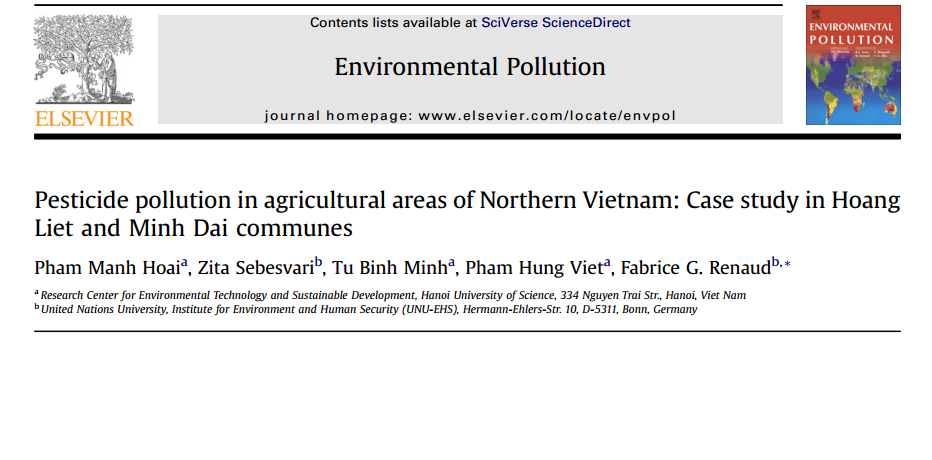
2011 | Elsevier
Keywords: Pesticide residues, Pollution, Water, Biota, Vietnam
Soils and agricultural products from the Red River basin in Northern Vietnam were reported to becontaminated by agrichemicals. To assess potential exposure of local farmers and consumers to thesecontaminants, pesticide use and management practices of local farmers were surveyed and residueconcentrations were determined for recently used as well as for banned pesticides in water, soil,vegetables, andfish samples in two communes of Northern Vietnam. DDTs, HCHs, and Drin compoundsstill persist at relatively high concentrations in soil and occur in vegetable andfish samples. Recentlyused pesticides, such as fenobucarb, trichlorfon, cyfluthrin, and cypermethrin were detected in vegetableandfish samples. Thresholds for acceptable daily intake levels (ADI) were frequently reached in theanalyzed food products pointing to the fact that current pesticide management practices do not onlyresult in a pollution of the environment but also pose threats to human health
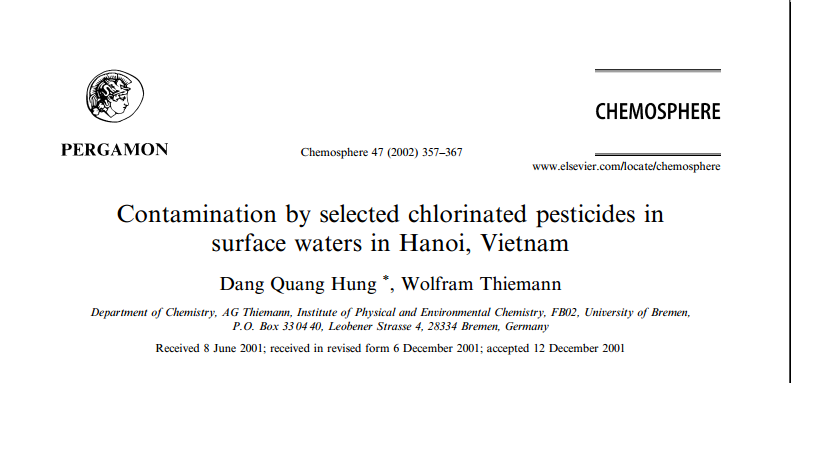
2002 | Elsevier
Keywords: Organochlorine, pesticides, Lindane, Malaria, DDT, River, water contamination
Fifteen insecticides, which were banned in Vietnam in the period from 1990 to 1998, were chosen for the investigation of surface water samples in Hanoi and its surroundings. The investigation was focused on an area of 30 by 20 km. Thirty water samples, in total were analysed: 11 samples from the Red river, seven from the Duong river, four from various lakes (West lake, Thuyen Quang, Bay Mau, Ba Mau), six from irrigation canals and two samples from wells. The procedure was repeated in November 1998 and in August 1999. The results showed that the contamination of the banned pesticides was highest in the rivers and then in the irrigation canals, followed by the lakes and wells.

2012 | AIT RRC.AP
Keywords: health care waste
Solid and Hazardous waste is increasingly becoming a major environmental burden of most urban and industrial areas. An alarming rate of solid and hazardous waste arising in Asia and the world has been witnessed parallel to urbanization, industrialization and economic development. Issues such as the increase in volume, variety of soid wastes, their qualitative diversification, and the trans-boundary movement of hazardous materials and soaring prices of resources now bound. The Thematic Working Group on Solid and Hazardous Waste (Waste TWG) of the Regional Forum on Environment and Health in Southeast and East Asian Countries was established in 2007 to address many of these problems. The goal of Waste TWG is to ensure environmentally sound management of solid and hazardous waste, particularly municipal and medical waste, and promote the 3R's.

2017 | AIT RRC.AP
Keywords: mercury , asean
The scoping study serves as a preliminary assessment of the current mercury waste management systems and practices in the ASEAN member states (AMS). It is aimed at identifying the current available sources of the relevant information, summarizing the essential information, and identifying gaps of information, challenges, needs and opportunities for further studies or actions. This study covers all AMS jurisdictions, while sector-wise, it focuses on Mercury in the Artisanal and Small-scale Gold Mining (ASGM); Mercury waste from the chemical manufacturing industry using the Chlor- Alkali process; as well as mercury in fluorescent lamps from industry and household sources. In terms of the Hazardous Waste Management (HWM) aspects under the BC Art. 4 and MC Art. 11, the study covers policies; legislative and regulatory framework; institutional framework; main sources/generators, waste prevention and minimization; handling, separation, collection, packaging and labelling, transportation, storage; treatment and disposal; and contaminated sites.
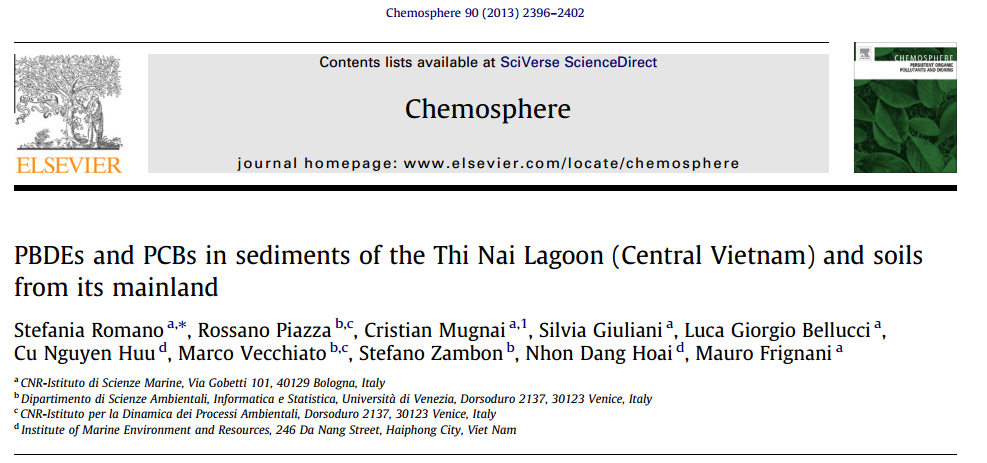
2013 | Elsevier
Keywords: PCBs, PBDEs, PCB 11, Sediments and soils, Thi Nai Lagoon, Central Vietnam
Concentration and distribution of PCBs, PCB 11, and PBDEs in both surficial sediment and soil samples,taken from a zone subject to recent accelerated development, were investigated to assess the environ-mental quality and understand both natural and anthropogenic processes that influence contaminantbehaviors. Values of PCB and PBDE are in the lower range of those reported in literature, typical of lowimpacted coastal zones.
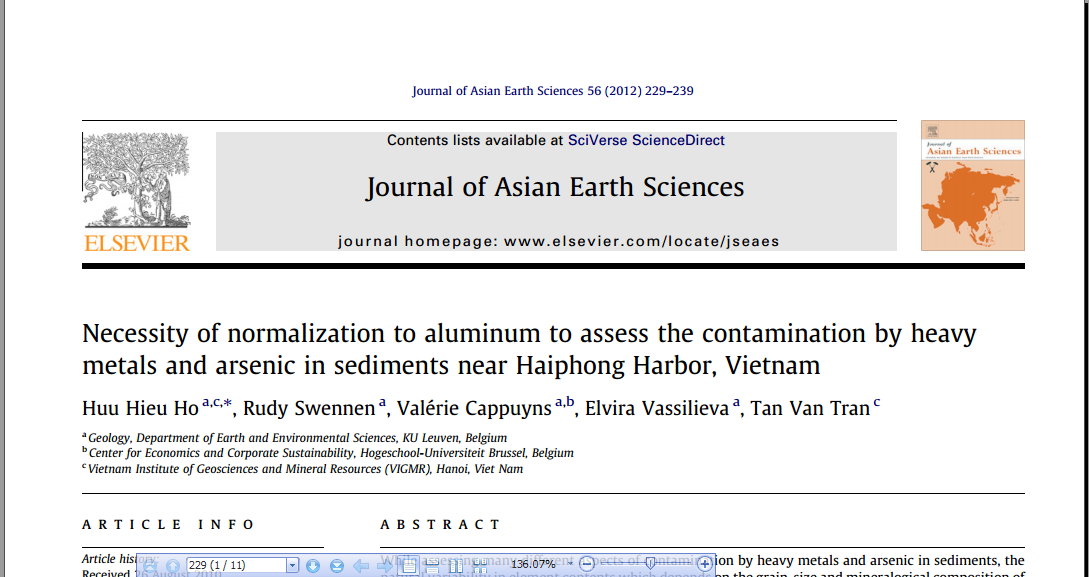
2012 | Elsevier
Keywords: Heavy metals, arsenic Sediment, Al-normalization, spatial distribution, Historical trend, Degree of enrichment
While assessing many different aspects of contamination by heavy metals and arsenic in sediments, the natural variability in element contents which depends on the grain-size and mineralogical composition of sediments, needs to be taken into account. In previous studies, the normalization of element contents to a reference element such as Al was commonly applied to compensate for granulometric and mineralogical effects. In the present study, through the investigation on the contamination of heavy metals and arsenic in sediments near Haiphong Harbor, the necessity of the normalization towards Al is assessed.
2011 | Health Care Without Harm
Keywords: Human rights, dump medicle waste, buring and incineration
The report is divided into two sections: the first reviews the human rights in question at the global level and includes the listing of scientific references and newspaper articles. Scientific articles are cited in the test in the normal way; newspaper articles are not all cited in the text, but are included to give the reader the fullest possible picture. Where possible, URLs are provided.
2011 | Health Care Without Harm
Keywords: Global green, healthy hospitals, Environmental Health, Hospital and health
We are living in a moment in which the twin crises of public health and the environment are merging, the confluence of the two magnifying the destruc-tive power of each. As they run together, the crosscurrents of disease and ecological deteriora-tion build on one another, becoming increasingly turbulent and damaging forces that are tearing at the very fabric of our societies. Climate change, chemical contamination, and unsustainable re-source use are all exacerbating ill-health the world over. These environmental health problems are increasing pressure on, and eroding the capacity of, already thinly stretched health care systems. Meanwhile, the health sector itself is paradoxically contributing to these very environmental health problems, even as it attempts to address their impacts.
2011 | ICRC International Committee of the Red Cross
Keywords: medical waste management
The world is generating more and more waste and hospi-tals and health centres are no exception. Medical waste can be infectious, contain toxic chemicals and pose contamina-tion risks to both people and the environment. If patients are to receive health care and recover in safe surroundings, waste must be disposed of safely. Choosing the correct course of action for the different types of waste and setting priorities are not always straightfor-ward, particularly when there is a limited budget. This manual provides guidance on what is essential and what actions are required to ensure the good management of waste.Drawing on the most up-to-date professional practice, the manual provides practical recommendations for use in the different contexts where the ICRC works. It includes techni-cal sheets ready for use, ideas for training and examples of job descriptions for hospital staff members. The guidance in this manual is applicable in resource poor countries as well as in countries where there is a more developed health infrastructure.
2010 |
Keywords:
Realizing the threats posed by healthcare waste, the Thematic Working Group on Solid and Hazardous Waste under the Regional Forum on Environment and Health considered it as an important area for action.The 3RKH and TWGSHW share common interests on healthcare waste as their priority areas. In view of this commonality, 3RKH was tasked with the assignment of preparing a Healthcare Waste status report. The task was initiated by 3RKH with the support from ADB and TWGSHW in turn supported by the Ministry of the Environment, Japan (MOEJ). This report titled "Healthcare Waste in Asia: Intuitions & Insights" is the outcome of the study. Understanding the liability of the study and its possible reflection on future decisions, information sources were selected with due care. Ministries and organizations related to healthcare waste were considered the key sources of information.

2010 | Elsevier
Keywords: PCBs, DDTs, HCHs, Sediment, Temporal trend
The occurrence, temporal trend, sources and toxicity of PCBs and organochlorine pesticides were investigated in sediment samples from the sewer system of Hanoi City, including the rivers Nhue, To Lich, Lu, Set, Kim Nguu and the Yen So Lake. In general, the concentrations of the pollutants followed the order DDTs > PCBs > HCHs > HCB. However, the pollution pattern was different for the DDTs and PCBs when the sampling locations were individually evaluated. The concentrations of the DDTs, PCBs, HCHs, and HCB ranged from 4.4 to 1100, 1.3 to 384, <0.2 to 36 and <0.2 to 22 ng/g d.w., respectively.
2010 | Health Care Without Harm , School of Public Health: UIC
Keywords: Pharmaceuticals in the Environment
Worldwide, pharmaceuticals save millions of lives by preventing and treating diseases, and improve the quality of life for those with a chronic condition. But these lifesaving properties come with an environmental downside. Recent widespread detection of pharmaceuticals in our waterways has generated publicconcern over the potential environmental and human health impacts associated with exposure. The unintended movement of biologically active, toxic, and hormone-disrupting compounds from pharmaceuticals to wastewater effluents and drinking water sources is an international problem that has been documented and publicly reported by government experts and academic researchers for nearly two decades.
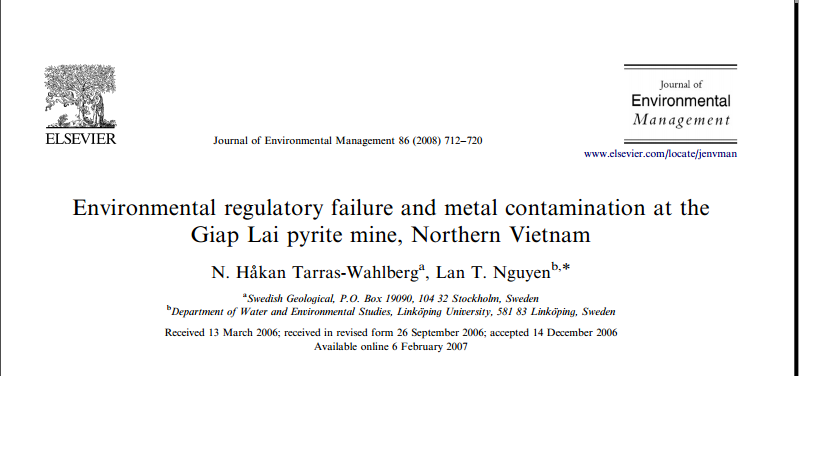
2008 | Elsevier
Keywords: Metal contamination, Environmental policy, Acid, rock drainage
The causes for the failure in enforcement of environmental regulations at the Giap Lai pyrite mine in northern Vietnam are considered and the environmental impacts that are associated with this mine are evaluated. It is shown that sulphide-rich tailings and waste rock in the mining area represent significant sources of acid rock drainage (ARD). The ARD is causing elevated metal levels in downstream water bodies, which in turn, represent a threat to both human health and to aquatic ecosystems. Metal concentrations in impacted surface waters have increased after mine closure, suggesting that impacts are becoming progressively more serious. No post-closure, remediation measures have been applied at the mine, in spite of the existence of environmental legislation and both central and regional institutions charged with environmental supervision and control. The research presented here provides further emphasis for the recommendation that, while government institutions may need to be strengthened, and environmental regulations need to be in place, true on the ground improvement in environmental quality in Vietnam and in many other developing countries require an increased focus on promoting public awareness of industrial environmental issues.
2005 | Health Care Without Harm
Keywords: bio-medical waste
The issue of medical waste management was first taken up in India around 1995.A lot has changed since then in the way medical waste is handled, stored, treated and disposed. An important catalyst to this change have been the Bio-medical Waste (Management &Handling) Rules 1998. Framing the rules was one important aspect of waste management, but implementing the rules required that the medical fraternity understood the rules and adopted them into their professional environments. This was possible only through large-scale training of medical staff. Considering the geographical spread of India, and the size of its medical sec-tor, this has been, and continues to be, a challenging task. Srishti, a programme of Toxics Link, has played its part in training healthcare professionals regarding medical waste management and the implementation of management systems in hospitals and other medical institutions.
2011 | UNEP
Keywords: mercury, gold mining
The Strategic Plan on Management of Mercury in Artisanal and Small Scale Gold Mining (SPASGM) was prepared by the Department of Environmental Pollution Control (DEPC), the Ministry of Environment (MOE), with support from the United Nations Environment Program (UNEP). This strategic plan was developed in response to various concerns on safe use and sound management regarding intentional mercury use in Artisanal and Small Scale Gold Mining (ASGM). This SPASGM is also developed and implemented to support existing legal frameworks, national strategies, action plans and many other relevant technical papers. Technical support for this development was administered by the UNEP Chemicals Branch through the Artisanal and Small Scale Gold Mining (ASGM) Project with in-kind contributions from the Royal Government of Cambodia.
2008 | Ministry of Environment, Cambodia
Keywords:
All over history, mercury has been known and used for gold and silver processing. In many parts of the world, mercury has been used in batteries, chlor-alkali production, dental amalgam, fluorescent lights, switches, and thermometers. Much of the mercury contained in these end-of-use products can be recycled; however, only a small amount of the mercury used is recycled. Mercury is a liquid metal, occurs naturally in a number of geologic environments, may be obtained as a by-product from precious metals mining, and is found in trace amounts in coal. Much of this mercury may be used and recycled; however, mercury used for gold production and mercury released from coal-fired power-plants, broken fluorescent lamps, battery production, and other sources is not recovered to any high degree and becomes a global environmental and human health concern. Minamata disease is an excellence example of mercury impact to the environment and human health in Japan, which brought a global concern of its release to the environment and seeking cooperation among countries for sound management of its release.
2005 | Resource Development International
Keywords: Mercury contamination, Mekong River
One of ten dolphins that died in the Mekong River had a presumed lethal concentration of mercury (67 ppm) in its liver. The mercury content of fish at Kratie was on average 102 ng/g (n=137) but in some species it was up to six fold higher. Hair in people collected in the drainage basin with gold mines (Ratanakirri) had significantly more mercury in their hair (4.4 ppm) than those living along the northern portion of the Mekong River (3.4 ppm). Males had significantly more mercury than woman (5.2 vs 3.1 ppm, respectively). Individuals had as much as 22 ppm of mercury in their hair. The concentration of mercury in a few percent of Khmers exceeds that in areas where mercury is associated with mercury poisoning. Gold mines in Cambodia are likely the major source of mercury but tree cores indicated a major flux of mercury associated with deforestation. Further analysis is required to determine what sources of mercury are manageable in Cambodia.
2004 | Ministry of Envrionment, Cambodia
Keywords: chemical production
In order to promote social development Cambodia, as well as other developing countries, has significant sectoral economic improvement including agriculture, industry and health. These sectors development activities have demanded high volume of chemicals uses, particularly in the last 10 years. All chemical substances imported have been distributed to different places and different sectoral users. Therefore, the import of chemicals, and the data and information concerning its use, have been maintained at different institutions. Cambodia has no centralized source for chemicals data and information, and currently lacks a national document. The lack of information and data collection has created problems for chemical management in Cambodia, particularly in ensuring technical management to protect public health and maintain a safe environment.
2004 | Department of Environmental Pollution Control; Ministry of Environment
Keywords: used lead acid battery
In the Kingdom of Cambodia, used lead acid batteries (ULAB) are not normally managed in an environmentally sound manner and there is no specific government institution responsible for ULAB management1. Detailed legislation specifically targeting the management of ULAB does not exist, except for some related statutory instruments such as the Law on Environmental Protection and Natural Resources Management; the Sub-Decree on Water Pollution Control; and the Sub-Decree on Solid Waste Management. Unsound ULAB management has caused concern for the environment and population health in Cambodia and there is an urgent need to improve the management mechanisms based on sound environmental practices, otherwise, harmful and irreparable consequences will occur in the future. The adverse health effects are a particular concern because they become another obstacle in the application of the Poverty Alleviation Program, which is the main policy of the present Royal Government of Cambodia.

1999 | UNHCR
Keywords: Toxic Justice, Toxic waste
In November 1998, nearly 3,000 tons of Taiwanese toxic waste were dumped in a field in the southern port of Sihanoukville. At the time, there was no law banning such dumping, but Minister of Environment Mok Mareth said publicly and repeatedly that toxic waste imports were prohibited in Cambodia and a national policy to that effect was in force. Dumped in an open field, the waste was scavenged by poor villagers, many of whom later complained of sickness; one quickly died. The Cambodian leadership, expressing outrage, promised a thorough investigation. Local people panicked: thousands fled the city. Others in Sihanoukville exercised their constitutional rights and in December held two days of public demonstrations, blaming government corruption for the presence of the toxic material. Even some local officials told Human Rights Watch they believed that demonstrations were warranted, provided they were lawful and peaceful. More details, pls visit the site.
| UN
Keywords:
Human Rights CouncilEighteenth sessionAgenda item 3Promotion and protection of all human rights, civil,political, economic, social and cultural rights,including the right to development In the present report, the Special Rapporteur focuses on the adverse effects that the unsound management and disposal of medical waste may have on the enjoyment of human rights. While approximately 75 to 80 per cent of the total waste generated by health-care establishments does not pose any particular risk to human health or the environment, the remaining waste is regarded as hazardous and may create a variety of health risks if not managed and disposed of in an appropriate manner. Hazardous health-care waste includes infectious waste, sharps, anatomical and pathological waste, obsolete or expired chemical products and pharmaceuticals, and radioactive materials. In many countries, significant challenges persist with regard to the proper management and disposal of health-care waste.